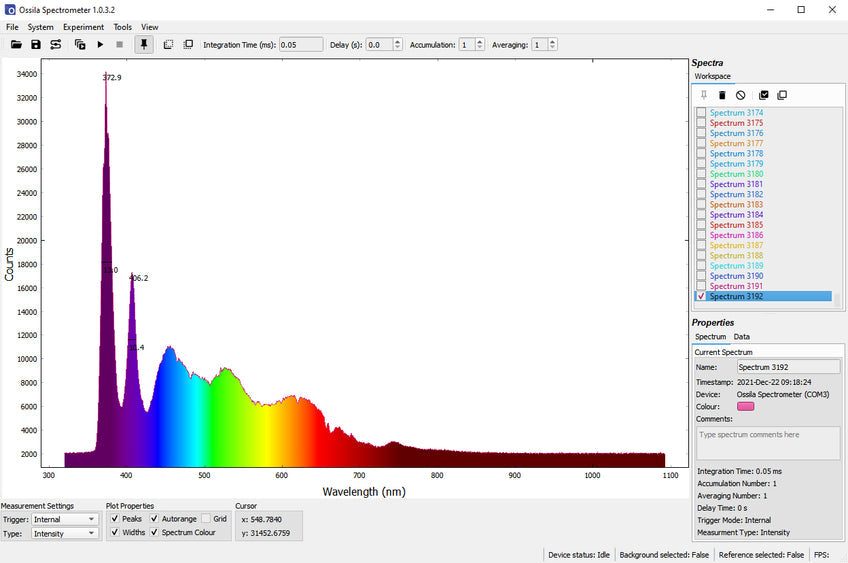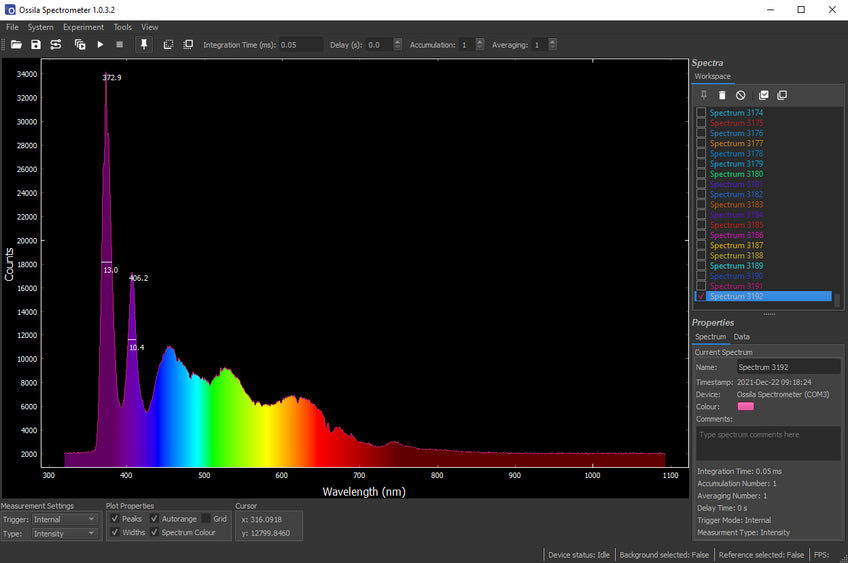Light Sources for Spectroscopy

Optical spectroscopy concerns light in the UV, visible and IR regions of the electromagnetic spectrum which is either emitted by, or interacts with, a sample. With our USB spectrometer, it can be performed using a range of different light sources. These can typically be categorized as being either monochromatic or broadband. The type of light source used in any spectroscopy set up will depend on the type of measurement being taken.
Generally, monochromatic sources are used to excite materials (for example, in fluorescence measurements) whereas broadband sources are used for absorption, transmission and reflection measurements.
Monochromatic Light Sources
Light Emitting Diodes (LEDs)
LEDs are a popular monochromatic light source due to their narrow emission spectrum, low power consumption, high stability, long lifetime and fast switching. In the past they were made from inorganic semiconductors, such as gallium arsenide (GaAs) and gallium arsenide phosphide (GaAsP). However, organic LEDs (OLEDs) have now become popular due to the broad range of colours which they are able to produce; by adding different functional groups to organic molecules, it is possible to alter their emission wavelength, making it relatively easy to fabricate LEDs of any colour.
Lasers
Lasers produce monochromatic, coherent, collimated light through the process of stimulated emission (hence LASER, or “Light Amplification by Stimulated Emission of Radiation”).
There are two types of lasers, continuous wave lasers and pulsed lasers. Continuous wave (CW) lasers produce a constant beam of photons with no fluctuation in power over time. Diode CW lasers are similar in design to LEDs, and are often used for measurements where very high powers are not necessary, such as fluorescence measurements. Compared to continuous wave lasers, diode lasers are much more affordable.
Pulsed lasers are very powerful as they are able to deposit very high amounts of energy in a short space of time. The pulse length used for fast spectroscopy is usually on the order of picoseconds (10-12 s) or femtoseconds (10-15 s), though attosecond (10-18 s) pulses are also possible. Pulsed lasers are often used in time-resolved measurements, such as transient absorption (pump-probe), or measurements that require very high energies - for example, as an excitation source for other lasers.
Pulsed lasers can also be used in non-linear optics to produce pulses of different wavelengths, such as in second harmonic generation (frequency doubling) or optical parametric amplification.
Broadband Light Sources
Broadband LEDs
Although individual LEDs produce light with a very narrow spectrum, multiple LEDs can be combined to produce a broader spectrum. It is also possible to coat the LEDs with phosphors - materials that absorb UV and blue light and re-emit in the visible - in order to cover the entire UV-vis spectrum. In this way, the Ossila Broadband White Light Source is able to produce light covering a spectral range of 360 - 900 nm.
LED light sources are typically more expensive than incandescent and gas discharge lamps, but their extended lifetimes mean they need to be replaced much less often, making them cheaper in the long run. They are also significantly more efficient as there is no energy lost through heat and their “warm up” and “cool down” times are instantaneous. Broadband LEDs can be powered over USB, are less fragile than lamp type light sources, and do not contain hazardous gases.


Tungsten Halogen
Tungsten halogen lamps (also referred to simply as halogen lamps or as quartz iodine lamps) are a type of incandescent lamp that emit from the UV-visible light boundary to the infra-red region. The exact spectral range depends on the temperature of the filament, but they are generally not suitable for measurements in the UV.
Tungsten halogen lamps consist of a tungsten filament inside a glass bulb. For this, quartz glass is used as it has a high melting point and is capable of withstanding high pressures without breaking. The capsule is filled with a mix of an inert gas, such as krypton or xenon, and a halogen, such as iodine or bromine.
The tungsten filament is heated by passing an electric current through it so that the filament becomes incandescent (it emits light). Most of the energy is emitted in the infrared, making tungsten halogen lamps very inefficient for day-to-day lighting but suitable for spectroscopy measurements in the IR region.
The inert gas in the glass bulb reduces the evaporation and oxidation of the tungsten filament, while the halogen helps to redeposit the tungsten particles back onto the filament through the “halogen cycle”. This increases the lifetime of the filament compared to incandescent lamps that do not contain any halogen, and reduces blackening caused by the deposition of tungsten particles on the inside of the glass.
Gas Discharge/Arc Lamps
Arc lamps are a type of gas discharge lamp which produce light by sending an electric discharge current through a plasma (an ionised gas). Generally, an electric field is applied between two electrodes inside a heat-resistant glass tube filled with the gas. The atoms become excited through ionisation or through collisions with electrons or other gas atoms or ions. When the atoms or ions relax back to the ground state, a photon is emitted. The wavelength of this photon is characterised by the gas used.
Deuterium arc lamps are commonly used in UV spectroscopy as they produce a continuous spectrum from around 180 - 370 nm (though there is non-continuous emission up to 900 nm). They are almost always combined with a tungsten halogen lamp to allow measurements in the UV, visible, and NIR.
Xenon arc lamps typically produce a continuous spectrum over a wavelength range of 190 - 1100 nm. This makes them more efficient than deuterium/tungsten halogen lamps as they can cover the same spectral range with only one lamp. However, they are both more expensive and less stable.
Light from discharge gas lamps is unpolarised and incoherent. Often they take a while to reach full light output power, but despite this, they are still more efficient than incandescent lamps.
LED Light Sources Set

Learn More
The Ossila USB Spectrometer has been designed to simplify the optical characterisation of thin films, solutions, nanocrystals, photonic structures, and more. A compact enclosure combines with powerful electronics to deliver a fast, reliable, and cost-effective device.
Read more... Optical Spectrometer
Optical Spectrometer
An optical spectrometer, also known as an optical spectrophotometer or spectrograph, is an instrument which measures light intensity across different wavelengths of the electromagnetic spectrum. This typically focuses on wavelengths within the visible light range (between 320-1000 nm).
Read more...